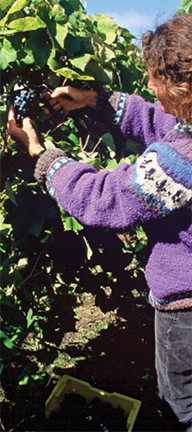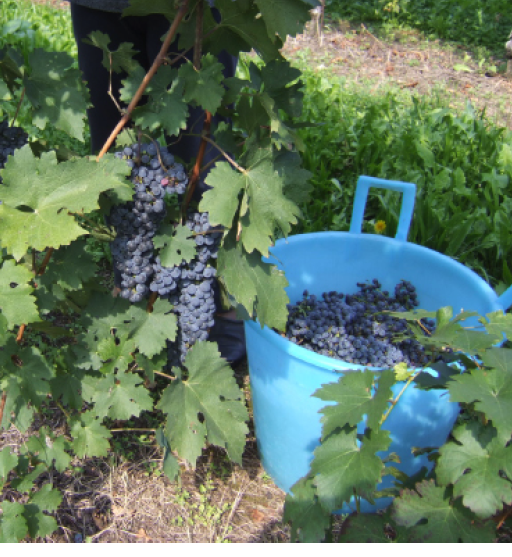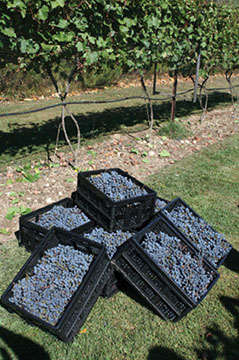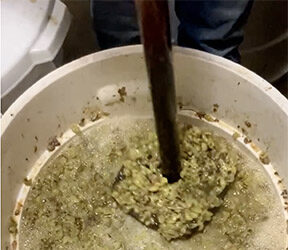
It takes many skills for a home winemaker to produce a high quality product. Although expertise in processing grapes goes a long way to accomplish this goal, having good fruit to work with is just as important. Applying the lesson from the fairy tale Rumplestiltskin, one cannot weave gold from straw nor is it possible to create a wonderful bottle of wine from sub-standard grapes.
While it is often convenient for home winemakers to purchase fresh or frozen juice from third party suppliers, procuring fresh grapes is another option, and if you source them directly from growers it can also prove to be more economical as there is no middle man involved. Putting aside cost considerations, the quality of grapes that can be found on vineyards is often excellent if you know how to source properly, which can help create amazing homemade wines.
The challenge, however, is growers who are willing to deal in relatively small volumes (compared to commercial wineries) for individuals who make their own product. The smallest amount that a farmer might be willing to sell is normally 300 lbs. (136 kg). They prefer to deal with winemakers who can buy larger lots. If there is a problem with purchasing large tonnages, sometimes it is possible for several winemakers to pool their resources to secure their grapes.
One example of someone who deals with this problem professionally is Michael Parker, whose company Calwinebroker.com sets up picks for home winemakers in local vineyards in California’s Eastern Contra Costa County. His business contracts with local growers with whom he brings from between 5 to 50 of his clients to harvest their grapes. Parker sells from between 35 to 40 tons a year, which serves hobby winemakers while taking the hassle out of dealing with small individual buyers by vineyard owners. However, this business model is fairly limited, and often only works in a limited geographical area where there is a lot of grapevine acreage (although there are other companies not located in wine country that source lots of wine grapes for hobby winemakers). In many cases, however, those making wine in small lots have to fend for themselves in finding grapes.
For vineyard owners, selling to hobbyists can have advantages as they can charge more than they can at a commercial winery. And in certain cases, selling small amounts of grapes for cash can have an upside for farmers who disdain paperwork. It is also common with growers who have only a small amount of tonnage to sell to work with small-fry buyers because they don’t have enough grapes for commercial wineries to bother with. Whatever the reasons, sourcing this fruit is a niche kind of activity. Kind of like home winemaking!
Making A Plan
The first thing to be determined when you’ve decided to source fresh grapes from a grower is to figure out when to start making arrangements for purchasing grapes. Normally this task is accomplished several months prior to harvest. This is because past purchasers often reserve product from year to year leaving growers with less of their crop to sell late in the season, and the rest of the crop is sold on a first-come/first-served basis. So it is important to find your source as early in the growing season as you can.
Finding good sources of grapes, especially for the first time buyer, is where things can get difficult. Websites of grape growers are a good place to start. There are many private and county grape growing associations, which can be used to find suppliers. Simply reaching out via email to individual wineries can also work. Also, if you purchase equipment from homebrewing/home winemaking stores, they can often pass along names of vineyards to their clients. If conventional methods don’t work, you can also drive around in wine country and knock on doors to find sellers. Often times if someone you meet at the vineyard is not in a position to sell, they will recommend a neighbor who can. And don’t limit yourself to just small-scale growers; even larger operations are sometimes willing to sell excess product, especially in years when the harvest is abundant. Being a hustler in finding grapes is a good attribute. To borrow a little league baseball axiom, “it just takes one” to find a friendly vineyard who will meet your needs.
When doing your research on grape sources, zero in on areas that grow your favorite grape varieties, and then consider price as compared to the region. Famed economist Adam Smith’s supply and demand curve applies in purchasing grapes regardless of location. For example, Merlot grapes from California’s Napa Valley region can cost twice as much as comparable grapes from Lodi, California. Where I live, in Northern California, I have a lot of choices; however, not everyone has such flexibility depending on where they live or how far they are willing to travel to find desired fruit. The good news is that once you’ve established a relationship with a grower, it is very possible to use the same source year after year. Getting your foot in the door with a grower is the most difficult challenge that home winemakers face.
 Bringing Home the Harvest
Bringing Home the Harvest
Once you’ve located a seller, the next question for a home winemaker is figuring out when to show up to pick up the grapes. The simple answer to this is: When the Brix of the grapes reaches optimum ripeness. This varies from around 20 for certain white wine grapes, to up to 30 for grapes used for late harvest and dessert wines.
Because there is a lot to know about the grapes as they grow, it is good to communicate with the grower in the weeks preceding harvest to keep track of when the moment is right to pluck grapes from their vines. This process is not totally predictable as variances in temperature and weather can change conditions, and the choice of when to pick can change in a hurry. Brix levels often change by 1 or 2 degrees in the final week prior to harvest, so when you approach harvest, be prepared for the grapes to come in in advance. For example, a sudden heat wave can raise the sugar levels in the grapes faster than anticipated. Conversely, a rainstorm or cold snap can cause the Brix to decrease temporarily. The important thing to remember is that when the grapes are ready for harvest, all other plans need to be dropped. Securing the grapes at the optimum moment has to be the top priority if you want to make wine from grapes fresh from the vineyard. Unfortunately, grapes don’t care what day of the week it is, if it is someone’s anniversary, or a party is being planned; lacking a social conscience, grapes need to be picked exactly when they are ready.
 Harvest Day
Harvest Day
When you show up to get your grapes, it is a good idea to bring your own refractometer along to assure the Brix level in a sample of grapes is within the range as advertised. You can also use a hydrometer for this task, which is less expensive but requires a larger juice sample. Virtually all reputable vineyards have their own tools for measuring Brix, but this is not an area where guessing or assuming should apply, especially when you are working with a small producer or with someone who grows grapes only as a hobby. Sometimes readings can vary when you set out to harvest; if they are way off, it is better to wait and pick the grapes another day, rather than pick grapes that will translate into less than optimum wine.
When you pick up the grapes, it is a good idea to leave your watch at home as delays are common.
Consider this the only thing you’ll do that day, even if you’re not harvesting yourself and just waiting for the grapes to come in from the field. Some grape growers like to use their own workers to harvest, while others like the idea of having buyers perform this function; it just depends on the grower. Naturally, it costs growers money to have their own team of workers pick the grapes, but this will assure them that the job is done right. Whatever the situation, home winemakers need to be flexible to meet the schedules of the grape growers. If possible, pick up all of your grapes in one day rather than going back again another day for more, especially if you’re helping with the harvest or if you are picking up grapes with a group of other winemakers or helpers as coordinating schedules and transportation for multiple days can be tough.
One of the most important rules to buying grapes from a grower is to be on your best behavior. When you and your friends step foot on a vineyard, think of it as though you are walking into your boss’s house. Being able to set foot on a vineyard is a privilege and honor; not a right. Being on a farm may not be the same as being a guest at a debutante ball, but courtesy should prevail at all times, especially on the first visit to a vineyard.
If you are allowed to pick your own fruit (which is more common at smaller producers), the grower may provide bins that hold anywhere from 25 to 35 lbs. (11 to 16 kg) of grapes. Normally, they will weigh 1 bin and approximate the final total based on the weight; otherwise they will weigh the entire lot on a large scale.
If the group that accompanies the home winemaker is doing the picking, it is best to bring your own equipment and supplies. This means coming prepared with a pair of clippers for everyone and and a supply of bottled water. Don’t overwork your harvest helpers. When picking grapes on hot summer days, it is best to start early in the morning and aim to finish by lunchtime. Since these volunteers are not hourly employees (and are most likely your friends), don’t expect a full day’s work. Four hours of work, with breaks, is plenty of time in the fields. If you’d like to include children on harvest day, check first with the owner of the property to see if they are welcome.
Also, if you and a crew of your choosing are allowed to pick the fruit yourselves, be sure to do a tutorial on the proper way to cut the grapes from the vines. It is very important to pick all of the bunches that are on the vines. Sometimes this can be a complicated task when there are rotten, raisined, or unripe grapes that are not suitable for making wine, and unfit grapes can be pruned off while picking. Don’t be too overly picky, though; you don’t want a “Frugal Fred” situation where the harvest crew cherry picks all of the perfect bunches and drops all the fruit that doesn’t seem worthy.
It is also important for pickers to be organized and operate in designated rows and not move around to where picking might seem easier. When the job of picking is completed, walk through where the crew has been working to make sure they did not leave any water bottles or other garbage behind. Vineyard owners don’t want to be on litter patrol for people they allow to be on their land.
If you have a crew, make a plan ahead of time for lunch and snacks. This is especially important if you want your friends to help you pick grapes more than one harvest. Solve the problem of making lots of food yourself by asking your friends to bring a potluck item. It is also nice to invite the vineyard owner to partake when appropriate. The bonding that often ensues when people break bread is not only enjoyable, but can also be a foundation for future grape harvests. And it goes without saying that bringing wine to share is a nice gesture.
When it is time to pay for grapes, cash is always appreciated, and some sellers also welcome checks. Payment method and price should be settled prior to harvest, however, to avoid any awkward moments.
Transport
Depending on the source of your grapes, sometimes the grapes can be crushed on site at the vineyard. Sometimes vineyard owners will provide equipment to crush grapes on their premises gratis or for a small fee. Other times it’s up to the winemaker to bring the grapes home for crushing. If the grapes are to be crushed at home, source some thick plastic liners to put in the bed of a pick-up truck or van (regular cars don’t tend to work very well for picking up large lots of grapes).
If the crush is done at the harvest site, bring a sufficient supply of clean, sanitized plastic garbage cans with lids (I prefer Rubbermaid as they never leak) to transport the must back home. It is also convenient to have some smaller 5-gallon (19-L) buckets handy to transfer product from the crusher to the garbage can on the truck bed. Depending on the size of the containers you use to transport the must, weights of 200 lbs. (91 kg)+ are not uncommon.
Also, have a supply of metabisulfite on hand so that you can add a couple of tablespoons (dissolved in water) in each container to inhibit wild yeast before you can introduce your chosen yeast strain back at the home winery. This will prevent any of those unwanted yeasts from taking hold and starting their own fermentation on the trip back home. Each of the garbage cans (fermenters) should be covered and taped shut in transit to avoid spills. If the grapes aren’t crushed, they should be sprayed with a sulfite solution. Grapes that are being transported to some remote location can start spoiling (e.g. oxidation) as berries split under pressure and release their juices, or perhaps there is some rot or damaged fruit. So you really need to thoroughly spray a sulfite solution on the grapes.
At home, make sure you have everything you need to make unloading easier. It’s good to have ramps available so that the heavy garbage cans can roll from the truck bed to the ground. A 2 x 6 x 8-foot piece of lumber works pretty well for this task. Having a few helpers to assist with this task is also advisable.
Go Forth and Source
The last tip for home winemakers who procure their own grapes is to make sure everyone has a good time and respects the process. Happy people make the best tasting wine. The best way to do this is to choose your team carefully, and have a solid plan in place before harvest day rolls around.
The quality of grapes that can be found on vineyards is often excellent if you know how to source properly.


 Bringing Home the Harvest
Bringing Home the Harvest Harvest Day
Harvest Day




